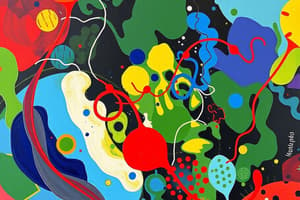Podcast
Questions and Answers
In which step of cellular respiration does the formation of FADH2 occur?
In which step of cellular respiration does the formation of FADH2 occur?
- Electron Transport Chain
- Glycolysis
- Krebs Cycle (correct)
- Pryuvate Oxidation
How many molecules of ATP are generated from glycolysis?
How many molecules of ATP are generated from glycolysis?
- 2 ATP (correct)
- 0 ATP
- 1 ATP
- 3 ATP
Which process releases CO2 as a byproduct?
Which process releases CO2 as a byproduct?
- Electron Transport Chain
- Lactic Acid Fermentation
- Pryuvate Oxidation (correct)
- Alcohol Fermentation
What compound is formed when pyruvate is converted to ethanol during alcohol fermentation?
What compound is formed when pyruvate is converted to ethanol during alcohol fermentation?
Which molecule combines with acetyl-CoA to form citrate in the Krebs Cycle?
Which molecule combines with acetyl-CoA to form citrate in the Krebs Cycle?
Where do electron carriers drop off electrons to generate ATP in cellular respiration?
Where do electron carriers drop off electrons to generate ATP in cellular respiration?
Which molecule in the TCA Cycle contributes directly to the formation of ATP?
Which molecule in the TCA Cycle contributes directly to the formation of ATP?
In cellular respiration, what is the primary role of CO2 release?
In cellular respiration, what is the primary role of CO2 release?
Which stage of cellular respiration directly involves the production of 2 ATP?
Which stage of cellular respiration directly involves the production of 2 ATP?
What compound is formed by the combination of oxaloacetate and acetyl-CoA at the beginning of the TCA Cycle?
What compound is formed by the combination of oxaloacetate and acetyl-CoA at the beginning of the TCA Cycle?
Which molecule directly interacts with cytochrome oxidase in the Electron Transport Chain to produce water?
Which molecule directly interacts with cytochrome oxidase in the Electron Transport Chain to produce water?
During chemiosmosis, the energy released as electrons move through the E.T.C. is primarily used for what purpose?
During chemiosmosis, the energy released as electrons move through the E.T.C. is primarily used for what purpose?
What is the key role of FADH2 in the process of ATP formation through oxidative phosphorylation?
What is the key role of FADH2 in the process of ATP formation through oxidative phosphorylation?
What is the total ATP yield per glucose molecule produced during oxidative phosphorylation?
What is the total ATP yield per glucose molecule produced during oxidative phosphorylation?
What is the fate of the electrons when there is no oxygen available as the final electron acceptor in the Electron Transport Chain?
What is the fate of the electrons when there is no oxygen available as the final electron acceptor in the Electron Transport Chain?
Which molecule serves as a precursor for the generation of oxaloacetate in cellular respiration?
Which molecule serves as a precursor for the generation of oxaloacetate in cellular respiration?
What happens if cyanide inhibits the enzyme cytochrome oxidase during cellular respiration?
What happens if cyanide inhibits the enzyme cytochrome oxidase during cellular respiration?
How does ATP production occur in chemiosmosis during oxidative phosphorylation?
How does ATP production occur in chemiosmosis during oxidative phosphorylation?
Study Notes
Cellular Respiration
-
FADH2 Formation: FADH2 is formed during the Krebs Cycle, specifically in the step catalyzed by the enzyme succinate dehydrogenase.
-
ATP from Glycolysis: Glycolysis generates a net total of 2 ATP molecules per glucose molecule.
-
CO2 Release: The Krebs Cycle releases carbon dioxide (CO2) as a byproduct.
-
Ethanol Formation: Acetaldehyde is formed when pyruvate is converted to ethanol during alcohol fermentation.
-
Citrate Formation: Oxaloacetate combines with acetyl-CoA to form citrate in the Krebs Cycle.
-
Electron Carrier Interaction: Electron carriers drop off electrons to the electron transport chain, specifically at complex I and complex II.
-
ATP Production in TCA Cycle: GTP is a direct contributor to ATP formation in the TCA cycle.
-
CO2 Release Role: CO2 release is crucial for maintaining cellular pH and regulating metabolic processes.
-
Direct ATP Production: The substrate-level phosphorylation step in glycolysis directly involves the production of 2 ATP molecules.
-
Citrate Formation in TCA Cycle: The combination of oxaloacetate and acetyl-CoA at the beginning of the TCA cycle yields citrate.
-
Cytochrome Oxidase Interaction: Reduced cytochrome c directly interacts with cytochrome oxidase in the Electron Transport Chain to produce water.
-
Energy Use in Chemiosmosis: During chemiosmosis, the energy released as electrons move through the ETC is mainly used to pump protons across the mitochondrial membrane, creating a concentration gradient.
-
FADH2 Role: FADH2 plays a role in ATP formation through oxidative phosphorylation by donating electrons to the electron transport chain at Complex II.
-
ATP Yield from Oxidative Phosphorylation: The total ATP yield per glucose molecule during oxidative phosphorylation is around 32-34 ATP molecules.
-
Electron Fate Without Oxygen: In the absence of oxygen, electrons are accepted by organic molecules, leading to fermentation.
-
Oxaloacetate Precursor: Malate serves as a precursor for the generation of oxaloacetate in cellular respiration.
-
Cyanide Inhibition: Cyanide inhibits cytochrome oxidase, preventing the electron transport chain from functioning and leading to ATP depletion.
-
Chemiosmosis ATP Production: The concentration gradient of protons generated in the intermembrane space is the driving force behind ATP synthase, which uses the energy to synthesize ATP through chemiosmosis.
Studying That Suits You
Use AI to generate personalized quizzes and flashcards to suit your learning preferences.
Description
Test your knowledge on cellular respiration processes such as Glycolysis, Pyruvate Oxidation, TCA Cycle, Electron Transport Chain, and Chemiosmosis. Learn about the ATP and NADH produced at each stage and the structure of the Electron Transport Chain.



